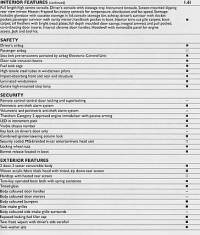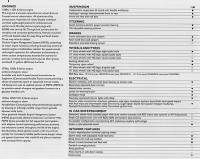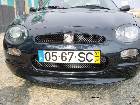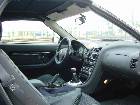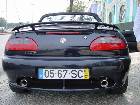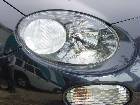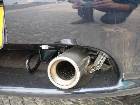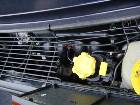|
Different parts at the
trophy, written by Roger Parker to the MG Cars BBS MGF Technical subject
From: Roger Parker Tamworth
roger.parker@virgin.net on 02 June 2001 at 12:35:36 (UK time)
OK petrol heads I have not been around here much lately, but that
is because I have been 'busy'!!!
Apart from enjoying well
over 30% more power, and a smoothness that is stunning, from the special
head and matched VVC inlet which effectively matches the Trophy. My
test drive of one some weeks ago did indicate to me that there was
at bets only 'tinkering' of the engine spec to raise the power and
the then non ownership of Powertrain shows why this route was followed.
(Costs!!) In the search for the differences I have identified the
greater proportion of the different parts used and below is a list
of what I have found in different sections.
I do expect this to be
printed and copied and pasted!!
Overview...
All parts listed are identified
as being different from the standard VVC that is built alongside.
It Follows that there are more differences between the Trophy and
earlier model VVC cars and even more when comparing with the non VVC
cars. I have also not looked closely at cosmetic changes so where
I have seen trim etc differences I have not recorded the changes.
One interesting
point has arisen is that the internal disturbances within Rover at
the time of the 2000MY car launch was clearly not fully documented
and as a result the latest parts slides refer to all the parts changes
applicable to this change as 'APPROX VIN XD511058'. This clearly means
that cars before and after what has to now been regarded as the change
point may well have 'odd' parts fitted. An example is a neibours 'W'
registered MGF which has orange indicators front and side.
Now to the Trophy research,
starting with the Engine...
There is no difference
between the normal VVC engine and the Throphy spec.
Fuel and Exhaust...
Air cleaner assembly is
specific to Trophy only. different parts are as follows...
PHB 000230 - air filter assembly (Same element as VVC)
PHD 000380 - air pipe from cleaner to throttle
PHU 000170 - air cleaner mounting bracket
The inference here is a modified air cleaner with larger bore air
feed. Note the resonator and cold air pick up are not showing changes
against current cars, but there have been recent changes compared
to older cars.
Exhaust Manifold has changed
for all ECD3 compliant cars inc all the Rover saloons and is a common
item. I do not know where the differences lie between this and the
older manifold.
Two exhaust differences
are found with the Trophy...
GEX 33778 - exhaust downpipe to cat
GEX 33779 - rear assembly (the main exhaust from cat)
The same standard cat is retained as all other cars.
The clear inference is
that the extra power for the Trophy comes from just air filter and
exhaust mods - much as many VVC owners have already done to similar
(or better) effect.
The alloy throttle body
of the Trophy is not specifically listed as all Manual cars still
have a part listing shown as a plastic body (MHB 102071) however the
throttle body for automatic cars is shown as MHB 102140, and there
is no reference to this being plastic.
Also all ECD3 compliant
cars (2001 on, On Board Diagnostics cars) have both pre and post oxygen
sensors in the exhaust so those who cling to the belief that cat removal
is worth while will have their desires canned since removal of the
cat will stop the engine working properly and drop the engine managment
into a failsafe reduced power mode. (For Deiter the VIN where ECD3
starts is 522573)
Side note - Recent mention
of cars having problems with poor running that has been found to be
the coolant temp sensor for the engine managment is interesting as
a new sensor with a blue plastic moulding (instead of black) has now
superceded previous sensors - GTR 240.
Cooling...
The engine bay cooling
fan is different from all other manual cars. It is shared with the
automatic cars (Stepspeed or Steptronic as it was previously called)
which indicates that it is able to move more air. (Auto cars will
hold higher rpms and as such should generate higher engine bay temps,
especially in urbal conditions.)
PGG000010 - engine bay cooling fan
Suspension...
Changes common to front and rear...
GSV1225 - Knuckles (lowered, four required)
RZR000010 - displacer springs (one per displacer)
Front only...
RNK000010 - Displacer, one per side!
RNP000060 - connection pipe to right hand displacer
RNP000070 - connection pipe to left hand displacer
RBJ000220 - Right hand lower suspension arm
RBJ000230 - Left hand lower suspension arm
Rear only...
RPJ000010 - Displacer, one per side
RNV000020 - bump stop, one per side
the rear displacer connection
pipes
RNP000100 - right hand
RNP000110 - left hand
These rear pipes connect
to the front via a common centre section which remains common to all
cars.
Interesting to see the
front lower arms are different, yet the replaceable parts, such as
the bushes and ball joint are common across the whole range.
Wheels...
RRC110460MNH - Trophy wheel 7x16
DTC000050MNH - wheel centre (one per wheel)
RRC001720EYP - Optional space saver wheel - steel
IMS Puncture repair system...
KFE000010 - puncture repair kit (all parts)
RRO100000 - sealant (part of KFE 000010)
KFJ000010 - Tyre valve core (part of KFE 000010)
KFK000010 - IMS label for tyre (part of KFE 000010)
FFH000010 - housing for this kit to sit in the car
The steel spare is large
enough to fit over the 304mm front brakes but it's size is not listed
and neither is the tyre size.
Brakes...
RFB000020 - Right hand front hub
RFB000030 - left hand front hub
RUB000140 - right hand front drive flange
RUB000150 - left hand front drive flange
GBD90850 - front disc
GBC90206 - left hand front caliper
GBC90207 - right hand front caliper
GRK905028 - caliper repair kit (one per caliper)
GBP90345AF - front brake pads
Flexible pipe feeds to
the front calipers are the same and the rear brakes show no changes.
It is interesting to note that the front hub changes list them a 'Trophy
Anti Lock braking'.
Chassis...
AAB460060A - Bodyshell, specific to Trophy
BMD4600050 - Bootlid
DFD000080LML - rear spoiler (in primer)
ESR1650 - nut and bolt kit for spoiler
There is no listing for
the front spoiler.
The parts slides note that the subframe to body mountings are specific
to the trophy, but doesn't list them.
The bodyshell shows some changes to the front side member assemblies,
but these are commonised for all ECD3 cars from VIN 522574. Quite
where the differences in the shell are is therefore not clear, but
may involve additional welding and other structural additions in the
actual assembly process rather than changes of parts used.
Electrical...
XBC000520 - Right headlamp, right hand drive
XBC000530 - Left headlamp, right hand drive
XBC000540 - Right headlamp, left and drive
XBC000550 - Left headlamp, left hand drive
Odds and ends...
DAH000060 - 'Trophy 160' rear badge
AWZ000040FAR - Can of spray paint, Trophy Yellow
AWZ000030JFV - Can of spray paint, Trophy Blue
AWZ000070FAR - Paint pencil, Trophy Yellow
AWZ000060JFV - Paint pencil, Trophy Blue
OK over to anyone who can
fill in any blanks!
Rog
--------------------------------------------------------------------------------
From: Rob Bell North London
on 04 June 2001 at 10:01:32 (UK time)
>>Side note - Recent mention of cars having problems with poor
running that has been found to be the coolant temp sensor for the
engine
managment is interesting as a new sensor with a blue plastic moulding
(instead of black) has now superceded previous sensors - GTR240.<<
Just to clarify my confusion
Rog- do you mean the new blue GTR 240 temperature sensor replaces
the old Brown GTR 206? I wonder what the improvement is, are they
retrofittable to older cars and if so, would they offer an advantage?
--------------------------------------------------------------------------------
From: Roger Parker Tamworth
roger.parker@virgin.net on 04 June 2001 at 17:31:32 (UK time)
Well spotted Rob, I missed entering the Trophy
The inner bushes for the
above are not listed as a different part to any other MGF.
The new coolant sensor
GTR 240 supercedes all previous sensor listings. As to benefits I
would simply say that changes are not done to pass the time of day
and usually it is a reult of two driving forces. 1, cost cutting and
2 replace a less than reliable part. In this case I favour item 2.
The ECD3 cars do, as far
as I am aware, all have to run with a pre and post cat lambda (oxygen)
sensor, and yes it does kill the prospect of those wishing to remove
their cats for whatever reason. On a more serious note it may also
have a retrograde impact on the use of a 'race' cat, depending on
what the parameters are for the allowable oxygen level in the post
cat gas make up. If the level is very strictly controlled then we
may see even the 'Race' cat not treat the exhaust sufficiently well
to avoid some failsafe cutting in.
Retro fitting of standard
parts makes things far more acceptable in terms of warranty issues,
but still would attract the insurers to increase premium. However
for some markets only manufacturers supplied parts or approved parts
are allowed full stop so here some will benefit.
Clearly any VVC owner should
be able to retro fit the Trophy induction and exhaust parts and expect
to achieve similar power. However I will refer back to my original
post which indicated that I was comparing current model cars with
the Trophy and that the listing is not an exhaustive one. In terms
of the power gains I would apportion a split of about 70/30 between
intake and exhaust changes.
For further information
the CD of the Trophy has been reduced from 0.36 to 0.35 and the CDA
by a similar 0.1point to 0.61. Not a huge amount and not what I would
expect to account for around a 3 to 4mph increase in top speed, which
is what the aerodynamic aids seem to be doing if the top speed claims
are confirmed.
Rog
|
